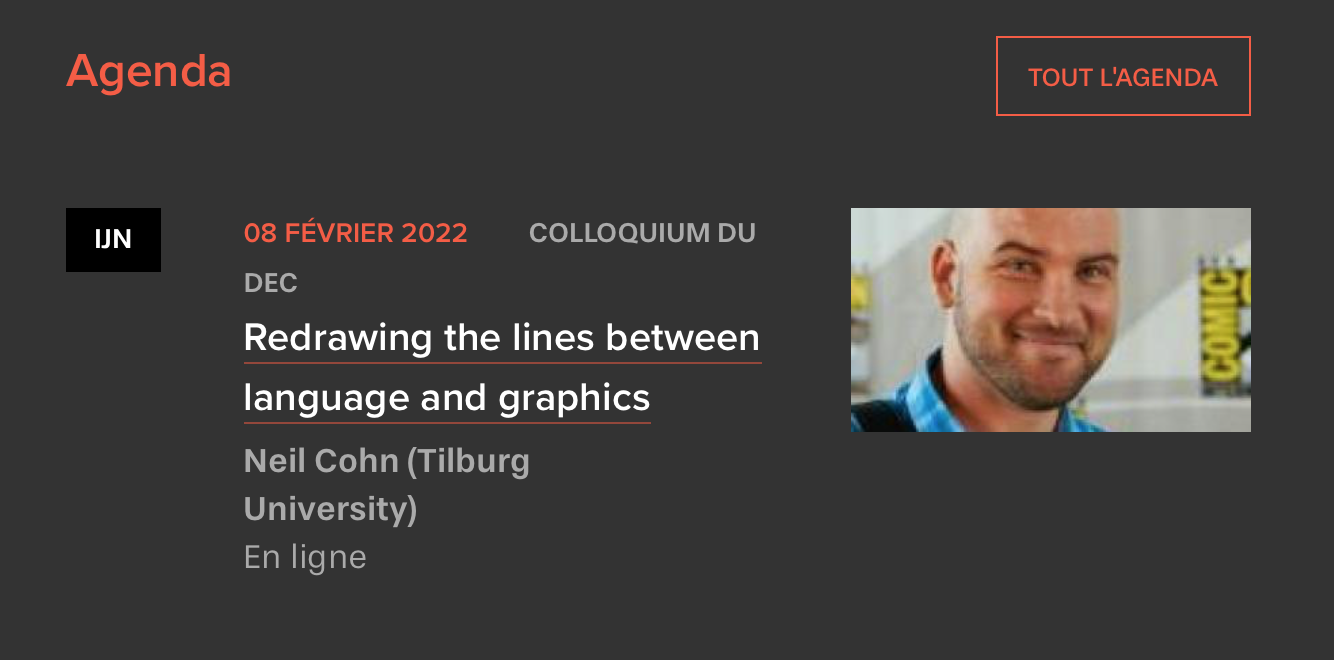RECHERCHE
Adrienne Fairhall, spécialiste des neurosciences théoriques, professeure invitée à l'ENS

Professeure de physiologie et de biophysique à l'Université de Washington à Seattle, Adrienne Fairhall est professeure invitée à l’ENS dans le cadre de la Chaire Tocqueville-Fulbright. Elle est accueillie depuis le mois de janvier au sein du Laboratoire de Neurosciences Cognitives et Computationnelles (LNC2) de DEC. Elle enseignera et partagera ses recherches dans le cadre de conférences et de workshops jusqu’en juin 2022.
Rencontre avec une spécialiste des neurosciences théoriques.
Lire l'article
Un jeu en ligne pour faire connaître la science de la forme des lettres

Des scientifiques du Max Planck Institute for the Science of Human History, de Harvard et de l'ENS-PSL ont conçu un jeu en ligne où les joueurs s'affrontent pour classer les formes des lettres des systèmes d'écriture du monde. Les chercheurs pourront mieux comprendre comment les formes des lettres évoluent pour devenir distinctes et informatives, grâce à cette typologie réalisée par le grand public.
Lire l’article
DISTINCTION
Anne Christophe a reçu la Légion d’Honneur au grade de Chevalier

Anne Christophe est directrice de recherche CNRS au Laboratoire de Sciences Cognitives et Psycholinguistique (LSCP) du DEC. Ses travaux de recherche portent sur l’acquisition du langage par le jeune enfant.
Elle est également directrice adjointe Science à l’ENS-PSL et membre du Comité Scientifique de l'Education Nationale.
Anne christophe vient de recevoir la Légion d’Honneur au grade de Chevalier. Cette distinction récompense vingt-sept années de service au sein de la recherche et de l’enseignement supérieur.
Lire l'article
CAMPUS
Un étudiant en sciences cognitives dans la saison 2 de "Dès Demain", le podcast de l’ENS sur l’environnement et le climat

Dans le podcast Dès demain produit par l’ENS, quatre étudiants s’interrogent sur l’environnement et les enjeux du climat. Pour comprendre la situation et agir à leur échelle, ils partent à la rencontre de chercheur.se.s, de climatologues, d'écologues ou encore d'historiens des sciences… Ensemble, ils décryptent les enjeux et problématiques de demain. Parmi eux, Blaž Istenic Urh, étudiant en sciences cognitives dans le cadre du DENS.
Au gré des six épisodes, l’École offre un accès privilégié aux travaux de scientifiques pour mieux comprendre notre époque et ses défis.
Une saison disponible depuis le 21 février.
Lire l'article
ÉVÉNEMENT
Semaine du Cerveau 2022 à l'ENS

La semaine du cerveau est un événement annuel qui se déroule dans plus de 120 villes dont le but est de partager connaissances et avancées de la recherche sur le cerveau à travers une programmation éclectique et surprenante : rencontres, conférences, animations, spectacles, cinés-débats, ateliers et expositions.
Un rendez-vous devenu incontournable pour le DEC et l'Institut de biologie de l'ENS (IBENS) qui proposent cinq conférences inédites du 14 au 18 mars à 19h30 à l'ENS.
Décrouvrez le programme et l'entretien avec Charlotte Jacquemot, directrice du DEC.
Lire l'article
DANS LES MÉDIAS
Un syndicat de plancton ?

Dans une tribune publiée sur www.lemonde.fr, les chercheur·se·s de l’équipe "Environnement : concepts et normes" à l'Institut Jean Nicod plaident pour reconnaître les droits et « la dignité de ce travail inlassable » du plancton qui produit l’oxygène nécessaire à la vie sur Terre, et séquestre du carbone.
Lire l'article.
Glyph, un jeu en ligne pour aider les scientifiques à percer les secrets des alphabets

Glyph, le nouveau jeu en ligne pour étudier les formes des lettres a été créé par une équipe dirigée par Yoolim Kim et Olivier Morin. Le but de ce jeu est de classer des caractères graphiques en fonction de règles que le joueur forge lui-même. Ce projet vise notamment à comprendre ce qu’il y a d’universel dans la conception et la perception des écritures, grâce à cette typologie réalisée par le grand public.
Retrouvez Olivier Morin sur www.vice.com, sur www.leparisien.fr, et également sur www.francetvinfo.fr
Lutter contre la désinformation ou se battre pour l'information ?

Le combat contre l'infox est une préoccupation majeure, mais il ne peut se faire sans le souci de défendre dans le même temps une information fiable et de qualité. L'un agit-il sur l'autre et de quelle manière ? Comment restaurer la confiance ?
Entretien dans "Les dessous de l'infox" sur www.rfi.fr avec Hugo Mercier, chercheur en sciences cognitives à l'Institut Jean Nicod et coauteur de l'étude "Lutter contre la désinformation ou se battre pour l'information ?"
À VOIR
Portrait de Catherine Tallon-Baudry, chercheuse en neurosciences, Talent CNRS 2021
Découvrez le portrait de Catherine Tallon-Baudry, chercheuse au Laboratoire de Neurosciences Cognitives et Computationnelles (LNC2), lauréate de la médaille d’argent CNRS pour ses travaux sur le rôle du couplage cerveau-viscères dans la formation de la conscience.
Lire l'article "Catherine Tallon-Baudry et Philippe Schlenker, lauréats de la prestigieuse médaille d’argent du CNRS"
QUELQUES PUBLICATIONS RÉCENTES
Nicolas Baumard, Elise Huillery, Alexandre Hyafil, Lou Safra (2022). The cultural evolution of love in literary history. Nat Hum Behav, doi:10.1038/s41562-022-01292-z
Résumé :
Since the late nineteenth century, cultural historians have noted that the importance of love increased during the Medieval and Early Modern European period (a phenomenon that was once referred to as the emergence of ‘courtly love’). However, more recent works have shown a similar increase in Chinese, Arabic, Persian, Indian and Japanese cultures. Why such a convergent evolution in very different cultures? Using qualitative and quantitative approaches, we leverage literary history and build a database of ancient literary fiction for 19 geographical areas and 77 historical periods covering 3,800 years, from the Middle Bronze Age to the Early Modern period. We first confirm that romantic elements have increased in Eurasian literary fiction over the past millennium, and that similar increases also occurred earlier, in Ancient Greece, Rome and Classical India. We then explore the ecological determinants of this increase. Consistent with hypotheses from cultural history and behavioural ecology, we show that a higher level of economic development is strongly associated with a greater incidence of love in narrative fiction (our proxy for the importance of love in a culture). To further test the causal role of economic development, we used a difference-in-difference method that exploits exogenous regional variations in economic development resulting from the adoption of the heavy plough in medieval Europe. Finally, we used probabilistic generative models to reconstruct the latent evolution of love and to assess the respective role of cultural diffusion and economic development.
Mélusine Boon-Falleur, Aurore Grandin, Nicolas Baumard et al. (2022). Leveraging social cognition to promote effective climate change mitigation. Nat. Clim. Chang., doi:10.1038/s41558-022-01312-w
Résumé :
Effective climate change mitigation is a social dilemma: the benefits are shared collectively but the costs are often private. To solve this dilemma, we argue that we must pay close attention to the nature and workings of human cooperation. We review three social cognition mechanisms that regulate cooperation: norm detection, reputation management and fairness computation. We show that each of these cognitive mechanisms can stand in the way of pro-environmental behaviours and limit the impact of environmental policies. At the same time, the very same mechanisms can be leveraged as powerful solutions for an effective climate change mitigation.
Charlotte Caucheteux, Jean-Rémi King (2022). Brains and algorithms partially converge in natural language processing. Commun Biol, 5, 134, doi:10.1038/s42003-022-03036-1
Résumé :
Deep learning algorithms trained to predict masked words from large amount of text have recently been shown to generate activations similar to those of the human brain. However, what drives this similarity remains currently unknown. Here, we systematically compare a variety of deep language models to identify the computational principles that lead them to generate brain-like representations of sentences. Specifically, we analyze the brain responses to 400 isolated sentences in a large cohort of 102 subjects, each recorded for two hours with functional magnetic resonance imaging (fMRI) and magnetoencephalography (MEG). We then test where and when each of these algorithms maps onto the brain responses. Finally, we estimate how the architecture, training, and performance of these models independently account for the generation of brain-like representations. Our analyses reveal two main findings. First, the similarity between the algorithms and the brain primarily depends on their ability to predict words from context. Second, this similarity reveals the rise and maintenance of perceptual, lexical, and compositional representations within each cortical region. Overall, this study shows that modern language algorithms partially converge towards brain-like solutions, and thus delineates a promising path to unravel the foundations of natural language processing.
Julie Grezes, Mégane Erblang, Emma Vilarem, Michael Quiquempoix, Pascal Van Beers, Mathias Guillard, Fabien Sauvet, Rocco Mennella, Arnaud Rabat (2022). Modifications des décisions d’évitement de visages menaçants lors d’une privation totale de sommeil en lien avec l’humeur positive des individus. Médecine du Sommeil, 19, 1, 29, ISSN 1769-4493, doi:10.1016/j.msom.2022.01.119.
Résumé :
Objectif
Malgré la connaissance d’un fonctionnement cognitif et socio-émotionnel altéré par une privation totale de sommeil (PTS), les mécanismes par lesquels la PTS altère les décisions dans des contextes sociaux sont peu rapportés. Nous voulons ici :
– caractériser, pour des sujets en PTS, les décisions de contacts sociaux avec des individus menaçants ;
– regarder l’influence du changement d’humeur.
Méthodes
Trente-quatre participants, reposé ou après une PTS (27 heures d’éveil), doivent spontanément choisir d’éviter (s’asseoir à côté) ou d’approcher (s’asseoir à l’apposé) d’individus menaçants (peur ou colère). Le changement d’humeur (PANAS) et les capacités d’attention soutenue (PVT) ont aussi été évalués.
Résultats
Bien reposé, les participants évitent les individus menaçants (plus fortement la colère que la peur). Après une PTS, les mêmes sujets continuent d’éviter les individus en colère mais ne font plus de choix clairs d’évitement pour les individus apeurés. Les modèles de décision (Drift-diffusion) révèlent que la PTS ralentirait l’accumulation de preuves (peur) qui aident à la décision. La réduction l’humeur positive (et pas négative) suite à la PTS est positivement corrélée à la réduction de l’évitement des individus apeurés sans aucun lien avec les déficits attentionnels.
Conclusion
Tous ces résultats soutiennent l’hypothèse, sous-estimée, d’une altération des choix d’évitement d’individus présentant des manifestations socio-émotionnelles (peur) qui deviennent ambiguës avec la PTS et qui passerait par une diminution de l’humeur positive des sujets.
Lara Narbona Sabaté, Geoffrey Mesbahi, Guillaume Dezecache, Cristiane Cäsar, Klaus Zuberbühler & Mélissa Berthet (2022). Animal linguistics in the making: the Urgency Principle and titi monkeys’ alarm system, Ethology Ecology & Evolution, doi: 10.1080/03949370.2021.2015452
Résumé :
The emergent field of animal linguistics applies linguistics tools to animal data in order to investigate potential linguistic-like properties of their communication. One of these tools is the “Urgency Principle”, a pragmatic principle stating that in an alarm sequence, calls providing information about the nature or location of a threat must come before those that do not. This theoretical principle has helped understand the alarm system of putty-nosed monkeys, but whether it is relevant for animal communication systems more generally remains to be tested. Moreover, while animal communication systems can convey information via a large set of encoding mechanisms, the Urgency Principle was developed for only one encoding mechanism, call ordering. Here, we propose to extend this principle to other encoding mechanisms and empirically test this with the alarm call system of black-fronted titi monkeys (Callicebus nigrifrons). We investigated how information about the context of emission unfolded with the emission of successive calls. Specifically, we analysed how contextual parameters influenced the gradual sequential organization of the first 50 calls in the sequence, using methods borrowed from computational linguistics and random forest algorithms. We hypothesized that, if the extended Urgency Principle reflected the sequential organization of titi monkey alarm call sequences, mechanisms encoding urgent information about the predatory situation should appear before encoding mechanisms that do not. Results supported the hypothesis that mechanisms encoding for urgent information relating to a predator event consistently appeared before mechanisms encoding for less-urgent social information. Our study suggests that the extended Urgency Principle applies more generally to animal communication, demonstrating that conceptual tools from linguistics can successfully be used to study nonhuman communication systems.
Léo Varnet and Christian Lorenzi (2022). Probing temporal modulation detection in white noise using intrinsic envelope fluctuations: A reverse-correlation study. The Journal of the Acoustical Society of America, 151, 1353, doi:10.1121/10.0009629
Résume :
Part of the detrimental effect caused by a stationary noise on sound perception results from the masking of relevant amplitude modulations (AM) in the signal by random intrinsic envelope fluctuations arising from the filtering of noise by cochlear channels. This study capitalizes on this phenomenon to probe AM detection strategies for human listeners using a reverse correlation analysis. Eight normal-hearing listeners were asked to detect the presence of a 4-Hz sinusoidal AM target applied to a 1-kHz tone carrier using a yes-no task with 3000 trials/participant. All stimuli were embedded in a white-noise masker. A reverse-correlation analysis was then carried on the data to compute “psychophysical kernels” showing which aspects of the stimulus' temporal envelope influenced the listener's responses. These results were compared to data simulated with different implementations of a modulation-filterbank model. Psychophysical kernels revealed that human listeners were able to track the position of AM peaks in the target, similar to the models. However, they also showed a marked temporal decay and a consistent phase shift compared to the ideal template. In light of the simulated data, this was interpreted as an evidence for the presence of phase uncertainty in the processing of intrinsic envelope fluctuations.
Léo Varnet, Alejandro Osses (2022). Auditory Classification Images: A Psychophysical Paradigm to Explore Listening Strategies in Phoneme Perception. ARO 2022, Online, United States.
Résumé :
The identification of the exact acoustic cues that listeners use when categorizing phonemes still constitutes an open question for research on speech perception. In this talk, we present a psychoacoustic reverse-correlation approach allowing direct investigation of individual listening strategies in phoneme perception. The Auditory Classification Image technique relies on a penalized Generalized Linear Model to link categorization errors in a speech-in-noise comprehension task with the corresponding distribution of the noise, on a trial-by-trial basis. We will also discuss recent improvements of the method designed to reduce the duration of the experiment.
Hualin Xiao, Brent Strickland & Sharon Peperkamp (2022). How fair is gender-fair language? Insights from gender ratio estimations in French. Journal of Language and Social Psychology, doi:10.1177/0261927X221084643
Résume :
Heated societal debates in various countries concern the use of gender-fair language, meant to replace the generic use of grammatically masculine forms. Advocates and opponents of gender-fair language disagree on – among other things – the question of whether masculine forms leave women underrepresented in people’s minds. We investigated the influence of linguistic form on the mental representations of gender in French. Participants read a short text about a professional gathering and estimated the percentages of men and women present at the gathering. Results showed higher estimates of the percentage of women in response to two gender-fair forms relative to the masculine form. Comparisons with normed data on people’s perception of real-world gender ratios additionally showed that the gender-fair forms removed or reduced a male bias for neutral- and female-stereotyped professions, respectively, yet induced a female bias for male-stereotyped professions. Thus, gender-fair language increases the prominence of women in the mind, but has varying effects on consistency, i.e., the match with default perceptions of real-world gender ratios.
AGENDA
Semaine du Cerveau 2022

La 24e édition de la Semaine du Cerveau aura lieu du 14 au 20 mars 2022 en France.
Une série de conférences seront données tous les soirs à l'ENS-PSL du 14 au 18 mars, à 19h30 par des chercheur.se.s du Département d'Etude Cognitives (DEC) et de l'IBENS.
Programme et inscription sur eventbrite .
Agenda des événements du DEC
Retrouvez tous les événements organisés par le DEC sur l'agenda du département.

Un grand nombre de séminaires et de conférences données par les chercheur.ses du DEC ou par nos invité.e.s sont accessibles sur :
- notre chaîne youtube,
- le site des Savoirs de l'ENS,
- la chaîne youtube de l'école
